Maximizing Your Network with WiFi Extenders and Ethernet
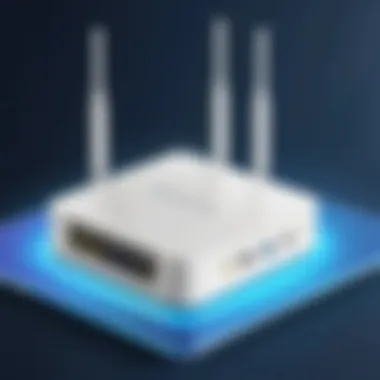

Intro
In the modern age of digital connectivity, having a reliable internet connection is a cornerstone of both professional environments and leisure activities. As technology evolves, so do the tools we use to maintain an online presence. One such tool that has gained traction is the WiFi extender—especially those with Ethernet output functionality. This technology plays a crucial role for individuals who rely heavily on stable internet connections, such as gamers and professionals working from home. Tackling the intricacies of WiFi extenders with Ethernet ports opens a window into not just how they work, but how they can enhance the overall online experience.
WiFi extenders bridge the gap between your router and distant devices, creating a seamless connection that boosts coverage in hard-to-reach areas. Imagine trying to work or play a game in a space where the WiFi signal barely registers. Frustrating, isn't it? This scenario is where extenders come into play—they help to eliminate those dead zones and ensure that your devices remain connected.
Equipped with Ethernet outputs, these extenders take connectivity a step further, providing wired connections for devices that require more stable and faster internet. This is a game-changer for anyone who needs reliability—like those streaming high-definition videos, participating in video calls, or engaging in competitive gaming.
In this article, we'll unpack the critical elements surrounding WiFi extenders with Ethernet output, including:
- Practical applications: How and where these devices can be used effectively.
- Configuration specifics: A step-by-step look at setting them up for optimal performance.
- Benefits: The advantages of using these extenders compared to other networking solutions.
- Troubleshooting tips: Insights on resolving common connectivity issues.
Let’s explore what makes these devices an essential addition to your networking setup.
Prelude to WiFi Extenders
In today’s fast-paced digital world, connectivity is everything. WiFi extenders play a crucial role in ensuring smooth internet access, particularly for those living in larger homes or utilizing high-bandwidth applications like gaming or streaming. The continual evolution of technology means that devices such as smartphones, laptops, and smart TVs require stable connections. This section delves into the fundamentals of WiFi extenders and sets the stage for deeper insights into their integration with Ethernet outputs.
Defining WiFi Extenders
Simply put, WiFi extenders are devices that boost the coverage of your existing WiFi signal. They grab the original signal from your router and re-broadcast it to areas that may experience weak connectivity. Think of them as bridges that fill the gaps where the signal struggles to reach. This is especially beneficial in multi-story houses or inhabited spaces where walls and other obstacles interfere with signal propagation.
Typically, the setup process includes plugging the extender into a power source and establishing a connection with your main router, which is often achieved through a straightforward pairing process. When the setup's done, users usually notice a marked improvement in their experience, particularly in zones that previously suffered from slow internet or dropouts.
The effectiveness of a WiFi extender hinges on its quality and compatibility with existing router technology. Thus, it is vital for users to research their specific needs, ensuring they choose a model that aligns well with their home and device ecosystem.
The Role of Ethernet Out
Ethernet output on WiFi extenders provides an additional layer of functionality. This feature is particularly advantageous for devices demanding stable internet connections, such as gaming consoles or desktop computers. By connecting directly through Ethernet, these devices can avoid potential latency issues that come with wireless signals, ensuring a reliable and speedy connection.
Using the Ethernet port effectively transforms the extender into a dual-use device: not only does it amplify the wireless signal, but it also serves as a wired network hub. This results in a seamless experience for both wireless and wired devices, catering to the needs of those who require the utmost performance.
By understanding the pivotal roles both WiFi extenders and Ethernet outputs play, users can enhance their network setup considerably, ultimately leading to a more constructive and enjoyable online experience.
The Necessity for WiFi Extenders
In the age of digital connectivity, WiFi extenders are becoming increasingly essential for many. The need for these devices arises primarily due to the consistent demand for reliable internet access in all corners of a home or office. The modern household often has numerous devices, ranging from smartphones to smart TVs, all vying for bandwidth. In a workplace setting, laptops, printers, and IoT devices create an even more complex scenario. Thus, ensuring consistent and strong WiFi signal coverage is no longer a luxury but a necessity.
Identifying Coverage Gaps
To fully grasp the necessity of WiFi extenders, one must first understand where coverage gaps tend to occur. Imagine moving from an open living room to a basement game room while on a video call. If the signal drops or becomes weak, it not only disrupts communication but can also impact online gaming experiences, leading to frustration or lag during crucial moments.
Here are some common coverage gap areas in homes and offices:
- Basements: Often the most neglected areas, they tend to be shielded by concrete, affecting signal strength.
- Garages: Similar to basements, garages are often difficult for signals to penetrate.
- Corners of large homes: In expansive spaces, the WiFi signal can’t always reach every corner effectively.
- Rooms with thick walls: Spaces separated by brick or metal can significantly hinder signal propagation.
By identifying these gaps, users can take necessary actions to enhance their connectivity, ensuring a seamless digital experience.
Common Scenarios Requiring Extension
Several scenarios highlight the urgent need for WiFi extenders. Here are a few situations that most users can resonate with:
- Streaming Services: Picture a family wanting to stream their favorite show in the living room while another is in the backyard. Without a robust signal, streaming can be disrupted, leading to buffering issues and disconnect.
- Online Gaming: For gaming enthusiasts, a reliable connection is paramount. High latency or dropouts can result in a significant disadvantage, especially during competitive play. An extender can often help maintain a stable connection even in the farthest gaming setups.
- Remote Work: With more people working from home, having reliable WiFi throughout the house is crucial. A poor connection can hinder productivity and create unnecessary stress.
- Smart Home Devices: As smart homes evolve, devices such as smart thermostats, security cameras, and lights rely heavily on stable WiFi. Weak signals can lead to connectivity issues, reducing the functionality of these devices.
Overall, recognizing the necessity for WiFi extenders transforms how users view their internet infrastructure. Instead of accepting weak signals, they can explore solutions that enhance their connectivity, turning their environment into a more effective digital space.
Technical Aspects of WiFi Extenders
The technical aspects of WiFi extenders are vital for comprehending how these devices integrate into your home or office network. Understanding these elements not only aids in selecting the right extender but also contributes to optimizing performance across your devices. Grasping the intricate mechanics undertone helps the user maximize their investments and ensures a smooth and seamless internet experience.
How WiFi Extenders Work
WiFi extenders function by receiving your existing WiFi signal and amplifying it to reach areas that are otherwise difficult to connect to. Essentially, take a less-than-stellar signal and boost it right through the walls. Imagine a DJ at a party, trying to liven up the crowd. The DJ doesn’t just crank up the volume; they adjust the music to make sure everyone can hear it clearly, wherever they are dancing. Similarly, a WiFi extender analyzes the incoming signal and sends out a stronger version of it.
Here’s a breakdown:
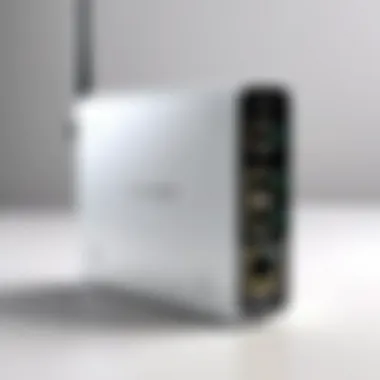
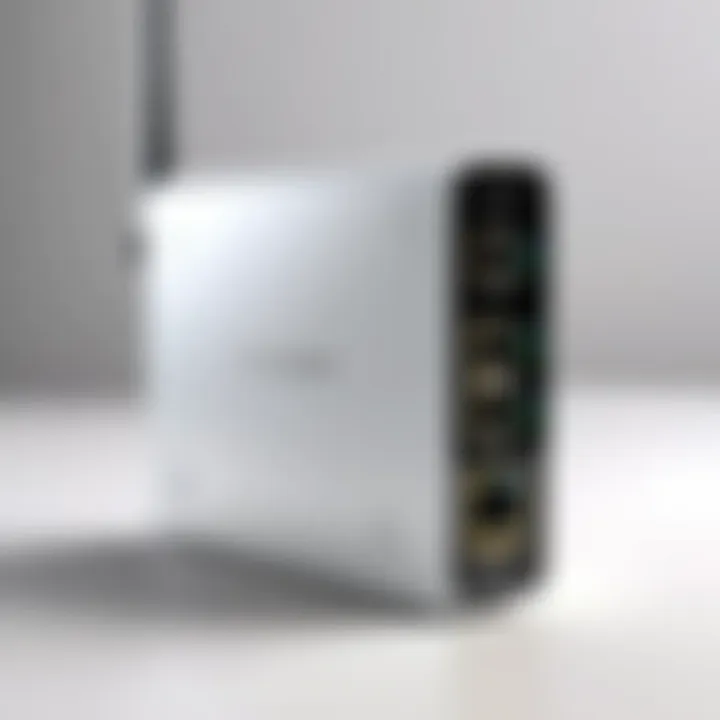
- Signal Reception: The extender first picks up the WiFi signal from your router. The location of the extender is crucial, needing to be within the coverage area of your router’s signal, like a tightrope walker keeping their balance on the line.
- Amplification: Once it grabs the signal, the extender processes and boosts it. This can involve re-encoding the signal to enhance performance and manage interference. It better prepares the signal just like a chef seasoning a dish, making it not overly salty yet just right for taste.
- Broadcasting: After amplification, it then sends the reinforced signal to areas where the original might have struggled. Ideally, this expands the reach without cluttering the channels with unnecessary noise, maintaining clarity.
In essence, WiFi extenders bridge the gaps in connectivity, especially in larger homes or spaces with multiple floors.
Difference Between Extenders and Repeaters
Although often used interchangeably, there are subtle distinctions between WiFi extenders and repeaters. Both work towards the common goal of enhancing coverage, but their methods and efficacy diverge rather significantly.
WiFi Extenders
- Functionality: They create a new network by connecting to the main router and transmitting a new signal.
- Performance: Generally, extenders maintain better signal quality and speed due to their ability to connect directly via Ethernet ports, if available.
- Ideal Use Case: Best utilized when tackling extensive coverage problems within spaces that require robust performance, like gaming setups or streaming centers.
WiFi Repeaters
- Functionality: They merely capture the existing signal and repeat it on a similar frequency—an echo of sorts, which can lead to slower speeds and performance setbacks.
- Performance: While they are simpler to set up, repeaters often suffer from reduced bandwidth since they relay one network, potentially causing delays or interruptions.
- Ideal Use Case: Suited for smaller spaces where coverage issues are less problematic and speed isn’t a major concern.
To sum it up, WiFi extenders usually offer a more reliable and higher quality solution, making them preferable for demanding environments. In the tech world, choosing the right tool can make all the difference; understanding these differences puts you one step ahead.
Ethernet Connectivity Explained
The ability to connect devices through Ethernet when using a WiFi extender can be a game changer for many. It's not just about boosting your wireless signal; it's also about creating a more stable and reliable network environment. For gamers or those streaming high-definition content, Ethernet connectivity provides a direct line to performance that WiFi alone may not always manage to deliver.
When considering WiFi extenders with Ethernet outputs, it’s essential to understand how these connections function within your network. Typically, these extenders receive your router's signal and then redistribute it to hard-to-reach areas. However, adding an Ethernet port allows users to connect devices like gaming consoles, smart TVs, or workstations directly to the extender. This setup minimizes latency, reducing the chances of lag during critical moments.
Understanding Ethernet Output
Ethernet output, in this context, refers to the physical ports provided by WiFi extenders, which allow for wired connections. Each Ethernet output often accommodates standard networking cables, such as CAT5e, CAT6, or CAT7, depending on the speed required. Here’s a breakdown:
- Standard Setup: Easy inclusion for devices that require substantial upload and download speeds.
- Reduced Interference: Unlike wireless connections susceptible to environmental factors, wired connections maintain a consistent signal.
- Device Flexibility: Your choice of connection can be adapted to include various devices, directly influencing their performance for online applications.
The importance of understanding how to use these Ethernet outputs can’t be overstated. Imagine a gamer trying to connect wirelessly during a high-stakes match, only to have the connection falter. Opting for a direct connection via Ethernet ensures that your performance remains solid.
Advantages of Ethernet Connections
Using Ethernet connections with your WiFi extender brings numerous advantages to the table:
- Higher Speeds: Wired connections are generally faster, making it ideal for high-bandwidth activities like gaming or video streaming.
- Lower Latency: When you connect via Ethernet, the round trip time for data returns to the device significantly decreases, resulting in less lag.
- Enhanced Security: Wired connections are more secure compared to wireless, minimizing the potential for unauthorized access.
- Network Optimization: Having a dedicated Ethernet connection frees up WiFi bandwidth for other devices, presenting a more balanced approach to network management.
- Simplicity of Use: Plugging in a cable is often simpler than troubleshooting connectivity issues with WiFi.
"A wired connection always beats wireless when it comes to stability. There's no debate when the stakes are this high."
In short, Ethernet connectivity through WiFi extenders not only enhances your network's capabilities but can also elevate your overall internet experience. Consider how you’ll use these capabilities to find the right balance between wired and wireless for your specific needs.
Setting Up Your WiFi Extender
Setting up your WiFi extender isn’t merely a simple plug-and-play task; it’s pivotal for ensuring that your internet experience runs as smooth as a new engine. This configuration process shapes how well your devices connect, the quality of your streaming, and even minimizes lag during the fiercest of gaming marathons. The mere act of deploying an extender can be the difference between a frustrating online session and seamless connectivity.
Understanding how to effectively set up your WiFi extender can amplify the strengths of your existing network, allowing you to tap into optimal performance. Every household or office is unique, and configurations need to be tailored to specific requirements. Having an extender configured properly can extend your reach, ensuring those dead zones are transformed into flourishing hotspots of connectivity.
Initial Configuration Steps
When it comes to the initial configuration, one must tread carefully. First things first, unbox your WiFi extender and check to see if everything’s included—power adapter, Ethernet cable, and the instruction manual. Failing to have the correct components can lead to unnecessary headaches later on.
- Location Choice: Choose a spot that’s neither too far from your router nor too close—around halfway is ideal. This ensures the extender captures a strong signal without being too distant from the source.
- Power Up: Plug the extender into an outlet and wait for it to power up. Most models feature indicator lights that signal readiness.
- Connect to the Router: Using your smartphone, tablet, or computer, connect to the extender’s network. It usually appears as a separate SSID, prompting easy identification. Follow the on-screen setup prompts. Many devices now incorporate intuitive apps that would guide users through the entire process.
- Network Name and Password: You will likely have the option to clone your existing WiFi network’s SSID and password, or create new ones. Using the same credentials might make switching between networks seamless.
- Firmware Updates: Once you’re in, check for updates. Manufacturers often roll out firmware updates to enhance performance and security.
Once these steps are secured, the gears of connectivity begin to turn.
Connecting to Ethernet Devices
Now, onto one of the standout features of modern WiFi extenders: their Ethernet ports. This functionality facilitates a wired connection that can significantly boost performance for devices that crave speed, such as gaming consoles and desktop computers.
- Identify Devices: Determine which devices will benefit the most from a direct Ethernet connection. Gaming consoles like PlayStation 5 and Xbox Series X require consistent performance for online play. Laptops used for heavy data transfer also fit this category.
- Ethernet Cable: Grab your Ethernet cable and connect one end into the port located on the extender. The other end connects to the device you are hoping to enhance. This simple step can lead to a markedly improved experience.
- Test Connectivity: Once plugged in, it’s crucial to run a test. Open a browser or a game and check for performance improvements. If everything is skimming along nicely, you're golden; if there are hiccups, troubleshooting may need to take place.
"The combination of a WiFi extender and wired connections is akin to having the best of both worlds, where flexibility meets speed."
Connecting devices via an Ethernet port doesn’t just improve stability; it also reduces latency and packet loss, ensuring that online experiences remain fluid and enjoyable. Thus, understanding these set-up intricacies is essential for those passionate about connectivity, enabling the establishment of a robust network that stands resilient against any challenges.
Optimizing Performance
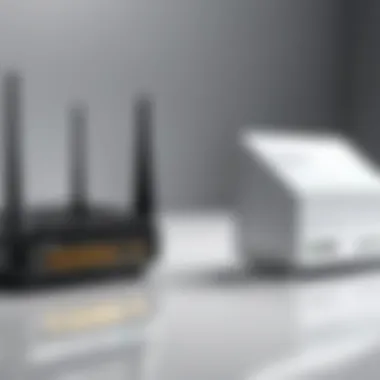
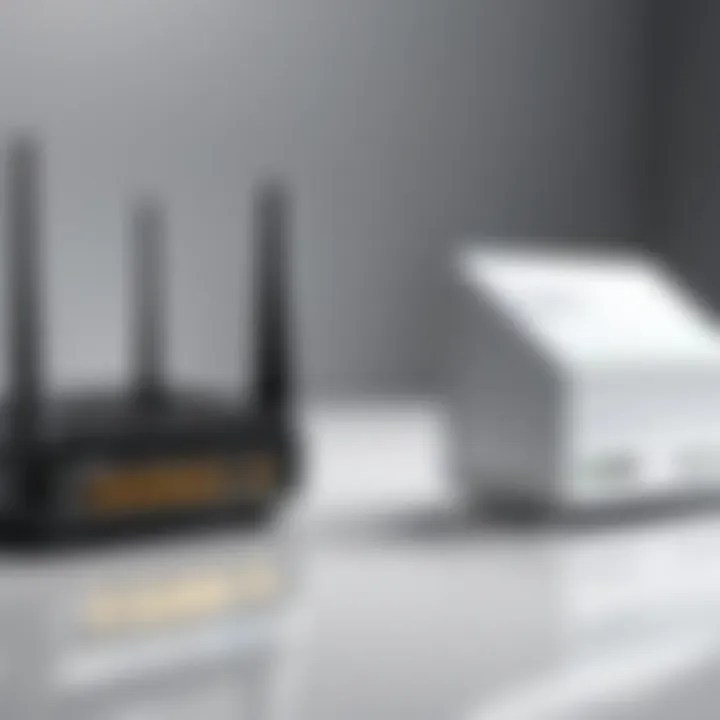
Optimizing the performance of WiFi extenders is crucial for ensuring a stable and rapid network connection. This section emphasizes key elements that significantly influence the overall effectiveness of these devices. From placement strategies to fine-tuning settings, each aspect plays a pivotal role in achieving seamless connectivity, particularly in environments where high data transfer is imperative, like gaming or streaming.
Best Placement for Coverage
Finding the optimal location for your WiFi extender can feel like searching for a needle in a haystack. Yet, it’s a task that can make or break your internet experience. Here’s how to master the art of placement:
- Midpoint Strategy: Place the extender halfway between your router and the area with weak signal. This strategic positioning helps in creating a sufficient overlap, ensuring a strong signal is relayed.
- Elevate the Extender: Height matters! Position the extender on a higher shelf or mount it on a wall. This reduces potential obstructions, maximizing coverage. Signals tend to travel better without interference from furniture or walls.
- Avoid Appliances: Stay away from electronic devices that emit extra signals, such as microwaves and cordless phones. These can create noise, disrupting connectivity.
- Test Signal Strength: After placement, it’s wise to test the network strength using devices in various locations. This practice helps in fine-tuning the position for optimal effectiveness.
"The right placement of your WiFi extender can feel like finding the perfect key for a complex lock—one small adjustment can unlock vast improvements in performance."
Adjusting Network Settings
Once your WiFi extender is physically set, tweaking your network settings takes it to the next level. Many users miss this crucial part, thinking that's all there is to optimization. Adjusting these settings can be the difference between an adequate connection and a blazing one.
- Change the Frequency Band: If your extender supports dual-band, try using the 5GHz band for devices like gaming consoles or smart TVs. This band typically comes with less interference which can provide a faster connection.
- Quality of Service (QoS): Enable QoS settings on your router. This feature lets you prioritize bandwidth for specific applications, ensuring that gaming or streaming hiccups become a rare occurrence.
- Channel Selection: Experiment with different channels. Depending on your surroundings, shifting to a less crowded channel can lead to a significant boost in speed.
- Firmware Updates: Always keep the extender's firmware up to date. These updates often fix bugs and improve performance. Just like maintaining a car, taking care of these updates can prevent future headaches.
By focusing on placement and settings, users can harness the full potential of their WiFi extenders. It's about making smart, informed choices that not only enhance connectivity but also contribute to a smoother online experience, particularly critical for tech-savvy households or gaming environments.
Troubleshooting Common Issues
In the realm of networking, even the best setups face hiccups from time to time. This is especially true with WiFi extenders with Ethernet output, which can be a godsend for improving coverage but can also lead to a fair share of challenges. Understanding how to troubleshoot common issues is pivotal for maintaining a seamless internet experience. By addressing these problems effectively, users can ensure their devices perform optimally, whether for gaming, streaming, or business use.
Connectivity Problems
Connectivity issues can throw a wrench into your plans. Often, users might find that their WiFi extender is not providing the expected boost. This situation usually arises from a few common culprits:
- Distance from Router: If your WiFi extender is too far from the main router, it may struggle to get a good signal, hindering its performance. Ensure it's placed within a reasonable range, ideally halfway between the router and the areas of weak signal.
- Interference: Other electronic devices like microwaves or cordless phones can interfere with the signal. Make sure the extender isn’t near such devices.
- Firmware Issues: Sometimes, the firmware on the extender needs updating. Not having the latest software can lead to connectivity problems, so check the manufacturer’s website for updates.
If the device is showing signs of connectivity problems, try rebooting both the router and the extender. This simple act can often resolve many minor issues. If the problem persists, consider connecting the extender directly through Ethernet to verify that the issue isn’t related to the router itself.
Performance Degradation
After setting everything up nicely, you might notice the speed isn’t as swift as you’d hoped. Performance degradation can arise due to various factors:
- Bandwidth Interference: If multiple devices are connected, they can siphon off bandwidth. For instance, during peak times, when family members are streaming videos while others are gaming, this can become a real bottleneck.
- Old Hardware: It’s not uncommon for an older extender or router to lag behind in performance. If your devices are several years old, it may be worth investing in new hardware that can better handle current internet demands.
- Positioning: The location of the extender plays a significant role in performance. Ensure it is away from obstacles like thick walls or furniture that could obstruct the signal.
If you suspect performance degradation, testing with a device directly connected to the extender via Ethernet can help determine where the slowdown is occurring. This isolation often shines a light on whether the issue is with the extender itself or the overall network environment.
"Constantly checking and optimizing your network can save a lot of frustration in the long run; it’s like preventive maintenance for your tech."
By identifying these common connectivity and performance issues, users can keep their WiFi extenders functioning optimally, maintaining a stable internet experience for all their online activities.
Comparative Analysis
In the realm of enhancing network connectivity, comparative analysis plays a vital role. It provides insight into different technologies, helping users understand which solution may best fit their specific needs. For someone standing at a crossroad between opting for WiFi extenders or exploring mesh networks, knowing the differences is crucial. These two approaches to networking serve similar purposes but operate distinctly, and this section aims to shed light on these variations.
WiFi Extenders vs. Mesh Networks
Let's dive into the first comparison: WiFi extenders and mesh networks. A WiFi extender works by capturing the existing signal and re-broadcasting it to extend the coverage area. It can be a simple, cost-effective solution for those looking to eliminate dead zones in their homes or offices.
On the flip side, mesh networks comprise several interconnected nodes that create a seamless wireless network. Each node communicates with others, ensuring a strong signal throughout the environment.
Some distinguishing factors include:
- Coverage Area: Mesh networks generally provide broader coverage compared to traditional extenders. If you have a large house or office spanning multiple floors, a mesh network might be the way to go.
- Ease of Use: Mesh networks usually come with user-friendly apps. These can guide you through the installation and management processes, something that might not always be the case with WiFi extenders.
- Speed Stability: Mesh networks often offer better speed stability as multiple nodes can handle more devices without slowing down the overall performance, whereas extenders can sometimes lead to reduced speeds, especially if placed too far from the router.
It’s essential to consider your specific usage requirements when deciding between these technologies. A home user with modest internet needs may find a WiFi extender sufficient, whereas a tech enthusiast or a gamer might be better served with a mesh network’s robust architecture.
Cost-Benefit Evaluation
The second aspect of our comparative analysis is the cost-benefit evaluation of these two technologies. When making any purchase, especially for tech, understanding what you get for your money is key.
For WiFi extenders, the initial investment tends to be lower. They can usually be found at most electronics retailers and online platforms without breaking the bank. However, this seemingly low cost can sometimes be misleading. If the extender doesn’t meet your needs—whether it be slow speeds or patchy connections—you might find yourself needing to buy a more robust solution in the long run.
Mesh networks typically require a more significant initial investment. Multiple nodes, while providing an effective overall network, can pile up the cost. However, they can also deliver long-term savings by ensuring you won’t be chasing after additional equipment later.


When weighing the costs, consider factors like:
- Long-Term Value: A more expensive mesh network may save you future purchases and frustration.
- Scalability: Mesh setups are often easier to expand. Adding another node can help accommodate increased demand as more devices connect to the internet.
Real-World Applications
Understanding the real-world applications of WiFi extenders with Ethernet output is crucial for maximizing network performance, particularly in settings that require reliable internet connectivity. Home users, business professionals, and gaming enthusiasts alike benefit from these devices. They bridge the gap between wireless signals and wired connections, ensuring seamless internet access where it matters most.
Using in Home Networks
Home networks often encounter dead zones, where WiFi signals struggle to reach due to distance or physical barriers. This is where the WiFi extender shines. Placing the extender strategically can eliminate these coverage gaps, resulting in buttery smooth streaming and gaming experiences. Here are a few practical applications:
- Enhanced Gaming: For avid gamers, a stable connection is vital. Using a WiFi extender to connect consoles like the PlayStation or Xbox can drastically reduce lag and improve performance.
- Smart Home Devices: As homes become smarter with devices such as smart cams, thermostats, and lights, maintaining a strong connection is essential. An extender can assist in keeping these devices synced and operational.
- Wiring Up Devices: If you have devices that require consistent internet, like a desktop computer or a smart TV, connecting these directly to the extender via Ethernet creates a stable relay of data, effectively improving speeds and reducing interruptions.
These scenarios showcase how a WiFi extender not only enhances coverage but also integrates seamlessly into the existing home setup, making life easier for all users.
Business and Office Setup
In a business environment, reliability translates to productivity. A strong and consistent internet connection can be the lifeblood for offices, especially those working with cloud-based solutions. Extenders with Ethernet outputs can be pivotal in maintaining work efficiency, particularly in larger office spaces where coverage might be less than ideal. Consider the following:
- Seamless Video Conferencing: With remote work becoming a norm, video conferencing tools are essential. Using a WiFi extender allows for clear and uninterrupted video calls, which helps maintain professionalism during meetings.
- Point of Sale Systems: Retail environments rely heavily on point of sale systems, which benefit from wired connections. An extender can provide the necessary connectivity to ensure transactions run smoothly.
- Network Segmentation: Many businesses have multiple departments, each with different internet needs. By using multiple extenders, businesses can create sub-networks. This setup reduces congestion and increases efficiency.
In summary, the application of WiFi extenders with Ethernet output serves as a vital component in both home and business settings. By enhancing reliability and efficiency, these devices allow users to fully take advantage of their internet connectivity, ultimately leading to more fruitful experiences, whether at home or in the workplace.
"In today’s connectivity-driven world, every drop of signal matters."
Their significance in both casual and professional contexts cannot be overstated, making them not just a luxury, but often a necessity.
Future Trends in Networking
In the rapidly evolving realm of connectivity, understanding the future trends in networking is pivotal for making informed decisions, particularly concerning WiFi extenders with Ethernet output. This exploration is relevant not just for tech enthusiasts, but also for users seeking stable and fast internet connections in both their homes and businesses. Adapting to forthcoming innovations can drastically enhance performance and user experience, ensuring that individuals harness the full potential of their network setups.
The significance of these trends encompasses several key elements:
- Increased Speed and Efficiency: The emergence of WiFi 6 and upcoming WiFi 7 technology promises faster data transfer rates and reduced latency. This directly impacts how WiFi extenders perform, providing opportunities for smoother connections, especially in environments with multiple devices.
- Enhanced Security Protocols: With cyber threats becoming more sophisticated, security is paramount. Future networking trends are focusing on robust encryption methods and protocols, meaning extenders will be better equipped to protect users' data against breaches.
- Improved Device Compatibility: As the variety of devices continues to grow, extenders will adapt by being compatible across an extensive range of IoT gadgets, making it easier for users to integrate new technology into their homes or offices.
"The future of networking is not just about connectivity; it's about creating seamless experiences that prioritize speed, security, and adaptability."
As one dives into the finer details of future trends, two significant areas stand out: advancements in WiFi technology and the role of IoT devices.
Advances in WiFi Technology
In examining advancements in WiFi technology, we find that the leap from WiFi 5 to WiFi 6 has already started reshaping how networks operate. WiFi 6 introduces features like Orthogonal Frequency Division Multiple Access (OFDMA) and Target Wake Time (TWT), which streamline communication between devices and reduce battery consumption. The result is an environment where connectivity is consistent and reliable, perfect for high-demand scenarios like gaming or streaming.
Moreover, the anticipated arrival of WiFi 7 promises even greater improvements. This standard aims to extend bandwidth, enhance data rates, and lower latency, pushing the envelope on what extenders can offer. As networks become denser, the ability for extenders to handle more connections simultaneously without sacrificing performance is imperative. This trend not only fosters robust gaming experiences but also supports emerging technologies such as augmented reality and virtual reality applications.
The Role of IoT Devices
The proliferation of Internet of Things (IoT) devices introduces a new layer of complexity and opportunity in networking. IoT is not just a buzzword; it's reshaping how we interact with technology at home and work. From smart thermostats to health-monitoring wearables, the diverse array of devices demands a reliable internet backbone that can seamlessly accommodate their communication needs.
As WiFi extenders integrate more deeply with IoT functionalities, their role shifts from merely boosting signals to providing a management framework for these devices. Users will benefit from the ability to prioritize bandwidth for critical applications while still ensuring that less demanding devices maintain connectivity.
In closing, keeping an eye on future trends is essential for anyone looking to optimize their networking setups. By anticipating advancements in technology and understanding the implications of IoT, users will be well-prepared to adapt their strategies for maximum efficiency and effectiveness.
Finale
In wrapping up our exploration of WiFi extenders equipped with Ethernet output, it’s crucial to grasp the significant role these devices play in enhancing network performance. A well-placed extender can make a world of difference, turning those frustrating dead zones in your living space or office into areas of connectivity bliss.
Summarizing Key Points
Throughout this article, we’ve delved into several key aspects:
- Understanding the Role: WiFi extenders serve as an essential bridge, helping to eliminate coverage gaps and ensuring robust internet access in even the farthest corners of a building.
- Ethernet Output Benefits: The ability to connect devices via Ethernet significantly boosts performance, providing stable, high-speed connections that WiFi alone can sometimes struggle to deliver.
- Setup and Optimization: We covered the setup procedures, emphasizing the importance of strategic placement and configuration to achieve optimal performance.
- Troubleshooting Techniques: Common connectivity and performance issues were discussed, alongside practical solutions to ensure your network runs smoothly.
- Future Insights: Finally, a glimpse into the future of networking technology pointed towards exciting advancements, especially concerning IoT devices, which are already starting to permeate everyday life.
Final Thoughts on WiFi Extenders
WiFi extenders, particularly those with Ethernet capability, are not just an afterthought in our modern, connected environments; they are a necessity, especially as our devices and online needs continue to proliferate. Investing in a quality extender isn’t just about improving internet speed; it’s about creating a seamless online experience whether you’re gaming, streaming, or working from home.
In an age where reliable and efficient connectivity can make or break your productivity, it’s worthwhile to take the plunge. With the insights from this article, you’re now equipped to make informed decisions about integrating WiFi extenders into your network setup, ensuring you stay ahead of the curve without getting tangled in the web of technical complexities.
"Ensuring robust connectivity isn’t just a luxury; it’s a fundamental need in our tech-heavy lives."
By understanding every facet of WiFi extenders and their Ethernet functionality, we pave the way for a more connected and efficient digital future.



